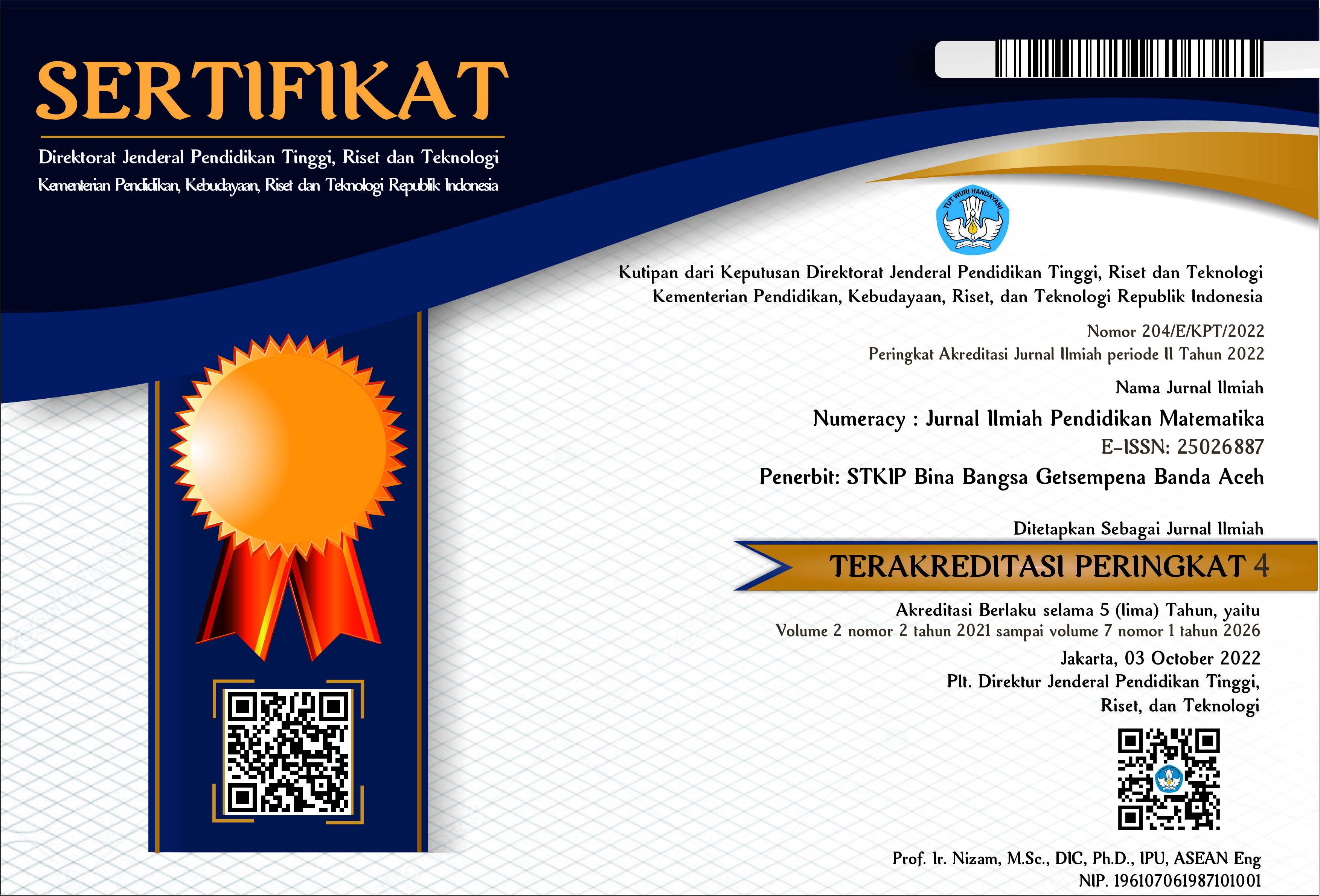PEMAHAMAN MATEMATIS SISWA DALAM PEMBELAJARAN PERSAMAAN LINEAR SATU VARIABEL MENGGUNAKAN ELPSA FRAMEWORK
Abstract
This paper aims to set out the level of mathematical understanding MTsNegeri 1 Takengon after taught with ELPSA. ELPSA component (Experience, Language, Pictorial, Symbol, and Application) implemented in the study of Linear equations of one Variable to dig a level deeper understanding mathematical students. This research is the research mix (mixed-method) using qualitative data to strengthen the quantitative findings.The research was carried out in Class VII MTs Negeri 1 Takengon involving 28 students. The level of mathematical understanding which is used is a level of understanding that developed from Skemp Kinach, where there are 5 levels of mathematical understanding: (1) understanding of the content, (2) understanding, (3) understanding of problem solving, (4), and epistemic (understanding 5) understanding Inkuiri. Based on the results of the study it can be concluded that learning through ELPSA (Experience, Language, Pictorial, Symbol, and Application) are generally the respondent has been able to achieve the level of problem solving. There is a small percentage of students who have achieved an understanding epistemic, but none reached the understanding of inkuiri.
Abstrak
Tulisan ini bertujuan untuk memaparkan tingkat pemahaman matematis siswa MTs Negeri 1 Takengon setelah diajarkan dengan ELPSA. Komponen ELPSA (Experience, Language, Pictorial, Symbol, dan Application) di implementasikan pada pembelajaran Persamaan Linear Satu Variabel untuk menggali level pemahaman matematis siswa. Penelitian ini merupakan penelitian campuran (mixed-method) yang menggunakan data kualitatif untuk memperkuat temuan kuantitatif. Penelitian dilaksanakan di kelas VII MTs Negeri 1 Takengon dengan melibatkan 28 siswa. Level pemahaman matematis yang digunakan adalah level pemahaman Kinach yang dikembangkan dari Skemp, dimana terdapat 5 level pemahaman matematis yakni: (1) pemahaman konten, (2) pemahaman Konsep, (3) pemahaman pemecahan masalah, (4) pemahaman epistemic, dan (5) pemahaman Inkuiri. Berdasarkan hasil penelitian dapat disimpulkan bahwa melalui pembelajaran ELPSA (Experience, Language, Pictorial, Symbol, dan Application) umumnya responden telah mampu mencapai level Pemecahan Masalah. Terdapat sebagian kecil siswa yang telah mencapai pemahaman epistemic, namun tidak ada yang mencapai pemahaman inkuiri.
Kata kunci: Pemahaman matematis, kerangka kerja ELPSA, pembelajaran matematika
References
Kinach, Barbara M.(2002).Understanding and Learning-to-explain by Representing Mathematics: Epistemological Dilemmas Facing Teacher Educators in the Secondary Mathematics ``Methods'' Course. Journal of Mathematics Teacher Education, 2002, Volume 5, Number 2, Page 153.
Lowrie, Tom dkk. 2014. Buku I Pengenalan Program: Bahan Belajar Geometri untuk Matematika SMP di MGMP. Jakarta: Bank Dunia.
Lowrie, T., & Patahuddin, S. M. (2015). ELPSA as a lesson design framework. Journal on Mathematics Education, 6(2), 1-15.
Perkins, D. N. & Simmons, R. (1988). Patterns of Misunderstanding: An Integrative Model for Science, Math, and Programming. Review of Educational Research, Vol. 58, No. 3 (Autumn, 1988), 303-326.
Resnick,L.B & Ford,W.W. 1981. The Psychology of Mathematics For Instruction. University of Pittsburgh Siswono, Tatag Yuli Eko. 2014. Permasalahan dalam pembelajaran Matematika. Makalah disajikan pada Diskusi Panel dan Workshop Program Studi S2 Pendidikan Matematika Pascasarjana Universitas Mahasaraswati Denpasar, 18 Januari 2014 di Ruang Widyasabha Kampus II Unmas Denpasar.
Skemp, R. R. (1976). Relational understanding and instrumental understanding. Mathematics Teaching, 77, 20-26.
Sutawidjaya Akbar. 2000. Pembelajaran Matematika Di Sekolah Dasar. Makalah seminar Nasional di Universitas Negeri Malang. Malang.



















